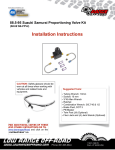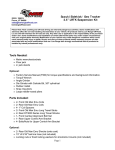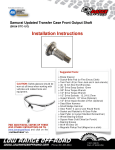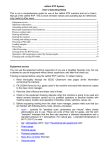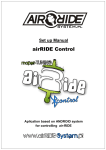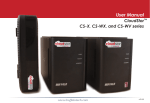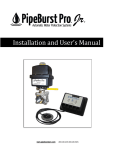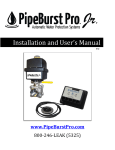Download SB-PPV1_86-88.5 Suzuki Samurai Proportioning Valve Kit
Transcript
Instructions Created by an: 86-88.5 Suzuki Samurai Proportioning Valve Kit (SKU# SB-PPV1) Installation Instructions CAUTION: Safety glasses should be worn at all times when working with vehicles and related tools and equipment. Suggested Tools: • • • • • • • • For additional copies of these and other instructions go to: www.lowrangeoffroad and click on the “Instructions” tab. Tubing Wrench: 10mm Socket: 10 mm Ratchet Combination Wrench: 3/8,7/16 & 1/2 Brake Fluid, DOT 3 PB Blaster Twin Post Lift (Optional) Floor Jack and (4) Jack Stands (Optional) A word about Brake Fluid 3 2 1. Brake fluid will tarnish and in some cases remove paint. If brake fluid should accidentally come in contact with painted surfaces, flush immediately with clean water. 2. Brake fluid can absorb moisture from the air. Moisture can lower the boiling point of the brake fluid and cause critical internal brake components to rust. For these reasons you should keep the container closed when not pouring from it. Further, to insure you are using good, clean, contaminate free brake fluid, always use fluid from a sealed container. 3. Always use the manufacturer recommend brake fluid. Suzuki recommends using DOT 3 Brake Fluid in their Samurai’s and Sidekicks. 4 5 1 7 6 Qty Number Figure A Description 1 1 Inlet Hard Line 1 2 PV Inlet Fitting 1 3 Proportioning Valve 1 4 PV Outlet Fitting 1 5 Outlet Hard Line 3 6 Metric Union 1 7 Metric Plug (not used in this application Step 1 Install and tighten the outlet fitting using a 7/16” open end wrench. Step 2 Install and tighten the inlet fitting in the same way. Step 3 Set up the rest of the proportioning valve assembly as shown here. Leave all these fittings loose for now and set this assembly aside. Step 4 Disconnect the front brake line using a 10 mm tubing wrench. Caution: Brake fluid will leak out. You may want to put a cloth or a pan underneath the brake line fitting to catch the drips. Step 5 Carefully bend the brake line slightly downward. Caution: Do not kink the brake line. Note: The corners of these fittings are easily rounded. Always use a tubing (or flare nut) wrench to loosen brake lines the first time. Step 6 Step 7 Position the proportioning valve assembly as shown and connect the brake line you disconnected earlier to the metric union. Connect the inlet hardline to the master cylinder. Leave all fittings hand tight for now. Toward the Existing Brake Line Toward Master Cylinder Tech Tip 7 Be sure the inlet of the proportioning valve is oriented toward the master cylinder and the outlet is oriented toward the brake line going toward the wheels. Step 8 Position the proportioning valve as shown here. Tightening all the fittings. Step 9 Tighten the fitting at the master cylinder using a 10 mm metric tubing wrench. Step 10 Hold the proportioning valve inlet fitting with a 7/16” wrench and tighten the inlet hard line fitting using a 3/8 open end wrench. Step 11 Step 12 Repeat Step 10 on the proportioning valve outlet fitting. Hold the metric union with a 1/2” open end wrench and tighten the fitting with a 10 mm open end wrench. Step 13 Tech Tip 13 Repeat the previous step on the other fitting connected to the metric coupler. This is what the proportioning valve assembly should look like when finished. Brake System Parts Identification Proportioning Valve Right Rear 6 Way Connector Left Rear Right Front Left Front Master Cylinder Figure B Swapping Two Brake Lines at the 6 Way Connector. This procedure converts the braking system from a “diagonal spit” braking system to a “frontrear split” system. Diagonal split means that one piston in the master cylinder controls the Right Front and the Left Rear Wheels and the other piston controls the Left Front and the Right Rear Wheels (See Figure C). After completing the procedures outlined below the system will be a front-to-rear split braking system (See Figure D). Meaning one piston in the master cylinder will control both front wheels and other piston will control both rear wheels. Converting to a front-to-rear split system will allow for an adjustable proportioning valve to be installed controlling the amount of braking done by the rear wheels. Diagonal Split System Forward Figure C Front-to-Rear Split System Forward Figure D Lifting and Supporting the Vehicle Tech Tip Step 14 Optional When working on suspension, brakes or drive train parts it is a good idea to spray all fasteners with penetrating oil a day ahead. If not done a day ahead, an hour or even minutes before is helpful. Lift and support the vehicle on a twin post lift. Front Floor Jack Rear Floor Jack Note: We used a twin post lift, but this job could also be done with a floor jack and (4) safety stands. It is also possible to do this job with the wheels on the ground if you desire. Step 15 Step 16 Remove the brake line shield by removing the (2) bolts using a 10 mm socket. Set the shield aside. Tech Tip 16 Step 17 Our objective is to swap these two brake lines. Note: This will allow the front brake line of the master cylinder to control both rear brakes and the rear brake line of the master cylinder to control both front brakes. Disconnect these two lines from the 6 way connector using a 10mm tubing wrench. Note: Fluid will run out, so place a pan under the fittings before you disconnect them. Step 18 Carefully bend each brake line and reconnect them as shown here. Caution: Be careful. If you try to make a bend that is too sharp the tubing will kink restricting flow of the fluid. Further, once the brake line becomes kinked any attempt to straighten it usually results in breaking the brake line. Step 20 Replace the brake line shield. Caution: Be sure the shield does not rub or contact the brake lines. Anything that is in constant contact with the brake lines can rub through, over time causing a leak. Step 19 Double check all the brake lines at the 6 way connection. Be sure all the fittings are tight and the brake lines are routed in a safe damage fee location. Bypassing the OEM Proportioning Valve Step 21 Loosen all four of the brake lines at the proportioning valve using a 10mm tubing wrench. (See Figure B for proportioning valve location) Step 22 Disconnect all four brake lines from the proportioning valve. Caution: These fittings can become rusted or corroded. You may want to spray them with a good penetrating Step 23 Dismount the proportioning valve using a 10mm socket. Step 24 Remove the proportioning valve and set it aside. Note: This part will not be needed for this install. Step 25 Step 26 Carefully bend the (2) inlet brake lines from a 90° angel to about a 45° angle as shown. Carefully bend the (2) outlet brake lines from a 0° (or straight) angle to about a 45° angle as shown. Step 27 Install the (2) supplied metric couplers as shown. Caution: Do not cross-thread these fittings. You may need to bend the brake lines a little more or less to get the fittings to start threading properly. Step 28 Hold the metric coupler using a 1/2” wrench and tighten the fittings using a 10 mm tubing wrench. Step 29 Tech Tip 29 Position the brake lines so that they do not rub, get dented or damaged in any way. This is what they should look like when completed. Final Checks Step 30 Step 31 Double check to see that all the fittings are tight. Double check all the brake line connections at the master cylinder. Be sure all the fittings are tight and the brake lines are routed in a safe damage fee environment. Step 32 Bleed the brake system according Suzuki Service Instructions. Note: For detailed instructions on bleeding Samurai brakes, go to Click on www.lowrangeoffroad.com. Instructions/Samurai Instructions/ Samurai Brake System Bleed. Or click HERE if you are viewing these instructions via computer, tablet or smart phone. Important Note: Come back to these instructions after successfully bleeding the system. You will need to adjust the proportioning valve. See the instructions on the next page. Adjusting the Proportioning Valve Step 33 1. Rotate proportioning valve dial counterclock-wise completely. This will fully decrease rear brake pressure. 2. Check tires for proper tire pressure. Tires with improper tire pressure will greatly effect this calibration procedure. 3. Locate an open dry hard surfaced parking lot (with no other vehicles around) to perform this calibration procedure. Calibration procedure requires at least 2 people to perform (1 Driver, 1 Observer). 4. Drive vehicle slowly and apply brakes to ensure calipers are functioning. If vehicle pulls hard in one direction when brakes are applied, calipers need inspection. Do not perform this calibration procedure if calipers are not functioning properly. Consult Suzuki service manual for inspection procedure. 5. In an open lot, drive vehicle 20 mph and apply brakes in an attempt to lock tires. The Observer needs to watch behavior of tires outside the vehicle. When braking, the Observer will see one of three possible situations: ! A) Front and rear tires lock simultaneously and equally. ! B) Front tires lock completely with rear tires slightly chirping (on the verge of locking). ! C) Front tires not locking at all and rear locking completely. 6. Proper brake bias will result when situation B in step 5 is reached. If situation A occurs, rotate proportioning valve dial clockwise 1/4 turn and repeat step 5. If situation C occurs, rotate proportioning valve counterclockwise 1/4 turn and repeat step 5. Although unlikely, if adjustment is necessary and no adjustment is left in proportioning valve dial, contact Low Range Off-Road for assistance. Congratulations! You have finished the proportioning valve installation. We hope these instructions have been helpful. If you have suggestions how we could make our instructions (or products better please email us at [email protected]. As always, If you experience any difficulty during the installation of this product please contact Low Range Off-Road Technical Support at 801-805-6644 M-F 7:30am-5:30pm MST. Thank you for purchasing from Low Range Off-Road. These instructions are designed as a general installation guide. Installation of many Low Range Off-Road products require specialized skills such as metal fabrication, welding and mechanical trouble shooting. If you have any questions or are unsure about how to proceed, please contact our shop at 801-805-6644 or seek help from a competent fabricator. Using fabrication tools such as welders, torches and grinders can cause serious bodily harm and death. Please operate equipment carefully and observe proper safety procedures. Rock crawling and off-road driving are inherently dangerous activities. Some modifications will adversely affect the on-road handling characteristics of your vehicle. All products sold by Low Range Off-Road are sold for off road use only. Any other use or application is the responsibility of the purchaser and/or user. Some modifications and installation of certain aftermarket parts may under certain circumstances void your original dealer warranty. Modification of your vehicle may create dangerous conditions, which could cause roll-overs resulting in serious bodily injury or death. Buyers and users of these products hereby expressly assume all risks associated with any such modifications and use. Revised 05/12/14© Copyright 2014 Low Range Off-Road, LC All Rights Reserved

















